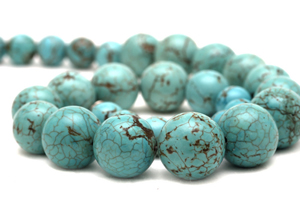Turquoise -a gem that brings good luck
"The stone that saves you from misfortune and brings good luck."
Judging from the fact that it was found in early Egyptian graves and treasures of the ancient Inca Empire, the history of Turquoise is old, thought to have been worn by people from around 3000 B.C.
Since it was found in the Caucasus, it was called "Carina" in Greece, and "Carez" during the Roman Era. It was not call Turquoise until the 13th century, when it was brought to Europe via Turkey from Iran and the Sinai Peninsula where it is mainly produced.
Turquoise is also known as a jewel that brings happiness to people, and there is a story behind why such powers are thought to be more effective if received as a present rather than buying it yourself. A Spaniard sold a turquoise that he had treasured for more than 30 years, and the man who bought it was the father of De Puto, the private doctor of Rudolph II Hapsburg (at that time, private doctors also took on the role of astrologer and personal advisor, and it is said that he told stories about gems to Emperor Rudolph). That particular turquoise was already faded in color and could not be considered valuable as a gem. However, the man gave it to his son saying, "It is said that the power of turquoise is effective only when given to you as a gift. So try for yourself to see whether this is true or not".
De Puto found this story hard to believe at first, but he accepted his father's kindness, engraved a seal onto the turquoise and kept it with him at all times. Then, before a full month had passed, the turquoise revived its beautiful blue color. Furthermore, the following year as he was returning to Bohemia after studying in Italy, he found that he must travel a dangerous mountain trail in the middle of the night. The carriage turned over having hit something in the darkness, and De Puto was thrown hard onto the ground, but survived the fall without a scratch. In the light of day the following morning, he saw that one fourth of the turquoise had chipped off, and he believed that the turquoise took his place in being injured.
Mysterious things continued to happen after that also, such as one time when he carried a very heavy log, he felt a searing pain and heard a sound like a bone breaking. However, there was nothing wrong with his body, and the turquoise this time was broken in half. Whether or not it was due to such stories, during the beginning of the 17th century, men in Europe were avid turquoise lovers, giving it the image of being a "man's necessity". Turquoise also was essential in parts of Central Asia, where it was considered to be the protective stone for camels and horses, thus there was the custom of making horses wear the gem at all times. On the other hand, if you are to speak of turquoise as being the protective stone for travel, you must not forget that Queen Isabelle of Spain gave a turquoise to Columbus, who mounted it into the compass before setting sail.
Turquoise is also known to indicate abnormalities to its owner by changing color, but this is due to the fact that this stone is easily affected by heat and sweat. Furthermore, turquoise is a stone that has many holes within the crystal. These holes are filled with liquid, so the stone cracks when this liquid dries. It is wise to use this gem for dressing up to go outdoors, but polish it clean afterwards with a soft cloth. Please refrain from washing it with water or using an ultrasonic cleansing machine. Water may seep into the holes and give the stone a dirty tint. Also, there are many stones using enhancement and synthetic stones, so beware when purchasing a turquoise.
Turquoise is found in Iran (best quality), Arizona, U.S.A. (greatest volume found), Egypt (with a green tint), and such. Though it is mostly barren of turquoise now, it is understood to have been mined in the Sinai Peninsula 5500 B.C., making this the oldest location of production. Color-wise, the homogeneous light-blue gem without a matrix (deposits composed from a mother rock) is considered to be the highest in quality, and such gems are called "Persian". The color is described as "robin’s egg blue". The runner-up is a homogeneous light-blue stone with a beautiful matrix in the pattern of a spider's web. In Arizona, the location of the greatest production, it is especially treasured by the Navajo Indians, as can be seen by the fact that turquoise is widely used in Indian jewelry. I personally feel familiarity with turquoise from Arizona, because the first turquoise that I owned was a necklace that I bought from a Native American when I traveled through Arizona with my brother and my friend. To think of it now, we had a very enjoyable trip thanks to the protective stone of travel that I acquired!
Turquoise teaches us about the happiness one can bestow upon others, and the beauty of one praying for good tidings during another person's journey. It is understandable why it was chosen as the birthstone for December, the month in which the most gifts are given.
